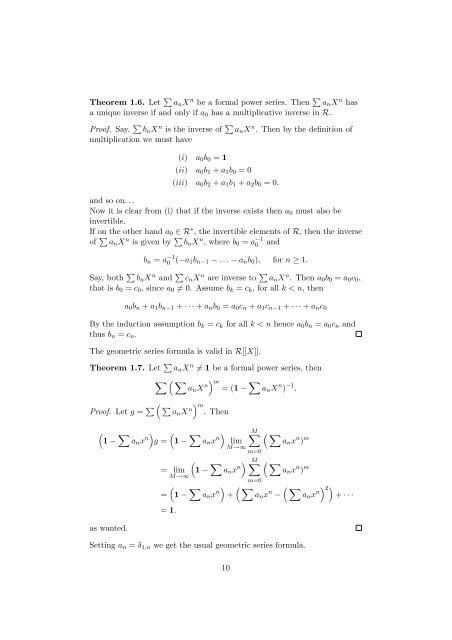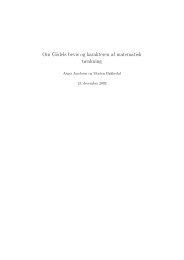Master Dissertation
Master Dissertation
Master Dissertation
You also want an ePaper? Increase the reach of your titles
YUMPU automatically turns print PDFs into web optimized ePapers that Google loves.
Theorem 1.6. Let anX n be a formal power series. Then anX n has<br />
a unique inverse if and only if a0 has a multiplicative inverse in R.<br />
Proof. Say, bnX n is the inverse of anX n . Then by the definition of<br />
multiplication we must have<br />
(i) a0b0 = 1<br />
(ii) a0b1 + a1b0 = 0<br />
(iii) a0b2 + a1b1 + a2b0 = 0.<br />
and so on. . .<br />
Now it is clear from (i) that if the inverse exists then a0 must also be<br />
invertible.<br />
If on the other hand a0 ∈ R ∗ , the invertible elements of R, then the inverse<br />
of anX n is given by bnX n , where b0 = a −1<br />
0 and<br />
bn = a −1<br />
0 (−a1bn−1 − . . . − anb0), for n ≥ 1.<br />
Say, both bnX n and cnX n are inverse to anX n . Then a0b0 = a0c0,<br />
that is b0 = c0, since a0 = 0. Assume bk = ck, for all k < n, then<br />
a0bn + a1bn−1 + · · · + anb0 = a0cn + a1cn−1 + · · · + anc0<br />
By the induction assumption bk = ck for all k < n hence a0bn = a0cn and<br />
thus bn = cn.<br />
The geometric series formula is valid in R[[X]].<br />
Theorem 1.7. Let anX n = 1 be a formal power series, then<br />
<br />
anX n m<br />
= (1 − anX n ) −1 .<br />
Proof. Let g = <br />
anX n<br />
m . Then<br />
<br />
1 − anx n<br />
<br />
g = 1 − anx n<br />
as wanted.<br />
lim<br />
M→∞<br />
m=0<br />
M <br />
anx n ) m<br />
<br />
= lim 1 −<br />
M→∞<br />
anx n M<br />
m=0<br />
<br />
= 1 − anx n<br />
<br />
+ anx n −<br />
= 1.<br />
anx n ) m<br />
Setting an = δ1,n we get the usual geometric series formula.<br />
10<br />
anx n 2<br />
+ · · ·



